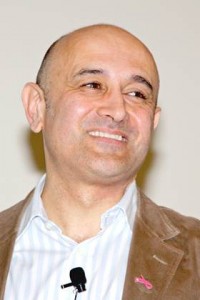April 4, 2011
Medieval Arabic Astronomy – Filling the gap between Ptolemy and Copernicus
Prof Jim Al Khalili
Report by: Chris Gadsden
Jim Al-Khalili is Professor of Theoretical Physics at the University of Surrey and also holds the Chair in the Public Engagement in Science. He is well known as the presenter of several excellent TV science programmes.
Jim began by explaining that he was born in Baghdad and his father had the foresight to leave Iraq and settle in UK before Saddam Hussein was firmly in control. He received all his secondary and further education in the UK. Tonight’s lecture was based on his book “ Pathfinders — The Golden Age of Arabic Science” (Allen Lane 2010) which describes the contributions made by Arabic scientists based in Iraq, Persia, and other centres in the medieval Islamic empire.
In the 8th Century, Baghdad (the “Round City”) was the centre of the civilised world. It was likely the largest city in the world from its foundation until the mid 10th century, with more than a million inhabitants at its peak. Caliph Harun al-Rashid kick-started its development as the centre of learning and later, Caliph al-Mamun founded a new academy, “The House of Wisdom”. Translations of ancient texts from Greek, Persian, Syriac, and Indian to Arabic were a key part of the early work and began the period known as “The Golden Age of Arabic Science”. The Arabic scientists did much more than preserve ancient learning through the translation movement; they added very significantly to our body of knowledge.
Jim talked about Al Khwarizmi (c780-850), the father of algebra. Indeed, the term algebra is derived from the arabic word al-Jebr ‘an equation’, and Al-Khwarizmi’s name, in it’s Latinized form Algorithmus, gives us the termalgorithm. Al-Khwarizmi devised a method of measuring the circumference of the Earth and he played a major part in introducing the Arabs to Hindu numerals. Evidence from some original manuscripts shows that the Islamic mathematicians were using decimal notation by the mid 9th century.
The next notable scholar of this period mentioned by Jim was al-Biruni (973 – 1048). He was a Persian polymath and can be compared to Leonardo da Vinci. One of his outstanding achievements was to measure the circumference of the Earth to an accuracy of 1%. He did this by measuring the height of a mountain (in modern Pakistan), and by ingenious geometrical methods then deduced the radius of the Earth, and hence its circumference.
Jim considered the greatest physicists in history, spanning 2000 years, to be: Archimedes (3rd C. BC); Ibn al-Haytham (11th C. AD); and Isaac Newton (17th C. AD). Al-Haytham made immense contributions to the study of optics and astronomy, and was one of the first philosophers seriously to question the work of Ptolemy. In his Almagest (itself the Arabic title), Ptolemy had given the world the geocentric theory. Arabic scholars, including Al-Haytham, were wedded to this theory, but Al-Haytham was highly critical of Ptolemy’s mathematical models of the solar system and devised far more sophisticated models of his own.
Nicolaus Copernicus was the Polish genius who is credited with being the first to propound the heliocentric model. But was he the first? Actually…No!
Aristarchus of Samos first promoted this idea in the 3rd C. BC – but nobody believed him!
Then Indian astronomers also proposed this theory, followed by the arabic astronomer, al-Sijzi (945-1020).
Copernicus was thought courageous in promoting the heliocentric theory, but he certainly used a lot of guesswork — there was no observational proof for the heliocentric theory! But it is clear that Islamic thinking and mathematics helped him significantly in his deliberations. Copernicus frequently refers to the work of Al-Battani and there is no doubt he used al-Tusi’s theories and maths about circles. In 1259 al-Tusi persuaded Hulagu Khan to construct the great observatory at Maragha east of Tehran. Maragha lends its name to the Maragha Revolution, a major reappraisal of Ptolemy’s work. Rather than seeing Copernicus as the ‘first’, it may be much more correct to see him as the last of the Maragha School.
Eventually Galileo was supreme; his application of the telescope to astronomy enabled the heliocentric theory to be proved beyond doubt.
Finally, Jim returned to the Islamist mathematician, Ibn al-Haytham (965 – 1039), who can be regarded as the first person to define the “Scientific Method”.
This was a fascinating and stimulating lecture by Prof Jim Al-Khalili, delivered to an attentive, and almost full, house and provided the opportunity for some pertinent questions from the audience during the Q & A session that followed.
Read More at —
Mapping the skies in medieval Islam
Wikipedia ‘astronomy in medieval Islam’
Islamic astronomy by Owen Gingerich
Al-Battani (Wikipedia)
Al-Battani (St Andrews)
Al-Tusi (St Andrews)
Some pictures from the evening [Pictures by Mike Dryland]:
Posted under: Flamsteed, Flamsteed Lecture, Meeting Report










You must be logged in to post a comment.